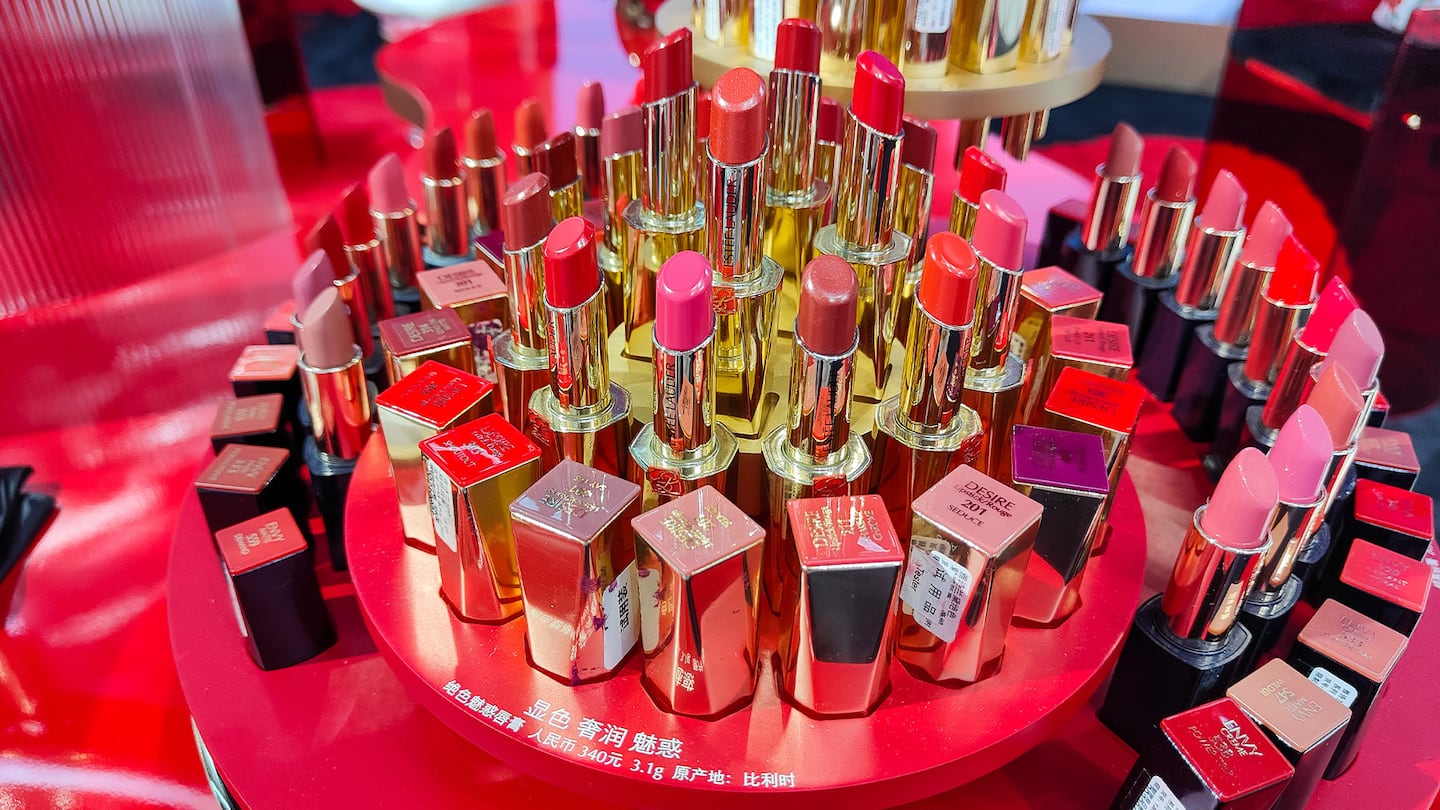
The Business of Fashion
Agenda-setting intelligence, analysis and advice for the global fashion community.

Agenda-setting intelligence, analysis and advice for the global fashion community.

China’s biggest e-commerce players didn’t want to talk about Singles Day results this year.
Sales, according to analysts, were generally lacklustre, as the country’s Zero Covid policy kept many under lockdown, and triggered some of the biggest protests in years. Beauty and personal care sales fared better than many other categories, however, growing 3 percent year-over-year on Tmall, said Adam Knight, co-founder of China consultancy Tong Global, which works with brands including Clinique, Charlotte Tilbury and Huda Beauty.
Still, big beauty companies are tempering their expectations. In its quarterly earnings released in November, The Estée Lauder Companies said it sees full year net sales decreasing between 6 to 8 percent versus last year.
In November, after nearly three years of draconian Covid-zero restrictions, frustration following a deadly fire in a lockdowned apartment building triggered nationwide protests. On Monday, Beijing announced it would loosen some policies in several cities, including Shenzhen and Shanghai. China’s economy is widely expected to grow by less than 3 percent this year, the slowest pace in decades.
ADVERTISEMENT
Amid the uncertainty, brands are putting on a show of business as usual, with exclusive products, activations and packages timed to the end of year holiday season, and upcoming celebrations like Lunar New Year and 5.20 Day (a local version of Valentine’s Day). But they’re largely sticking with their long-term China strategies in hopes this year’s turbulence will soon subside.
“China still remains the biggest opportunity for growth anywhere in the world, but it’s become a lot harder [to win],” Knight said. “It’s a lot more expensive as a source of growth, but show me another market that has the same potential.”
Brands are hoping for stronger holiday sales, even as protests and rising Covid cases continue.
To tempt shoppers, they’re pushing exclusivity and urgency with special holiday gift boxes and products. Labels like Helena Rubenstein, YSL, Dior Beauty, Christian Louboutin Beauty, for example, are pushing out hero products in popular Advent calendar formats. Companies are also zooming in on popular gifting categories like fragrance.
“Most brands are giving consumers every reason to [gift]. Brands want to capitalise on the year end bonus season where consumers would have extra cash to splurge,” said Adrian Peh, general manager of fashion and beauty for Asian marketing and brand experiences firm Gusto Collective, in an email to BoF. Gusto Collective has worked with brands including Rituals, Harrod’s and Stella McCartney.
Meanwhile, Estée Lauder said on its latest earnings call, it would put a renewed holiday focus on fragrance, which rose 18 percent in all regions as of first quarter 2023. The conglomerate said it would shift its strategy toward “the luxury of seasonal fragrances” by highlighting its strongest perfume brands like Jo Malone London.
Alongside newness and seasonal promotions, companies are also reducing their immediate risk.
After noticing October footfall down 70 percent in China’s duty free shopping behemoth Hainan — which has been wracked with rolling closures since the onset of the pandemic — Estée Lauder said it would lower inventory levels in travel retail and Asia (though it also opened a flagship store for the Estée Lauder brand in Hainan in November). The conglomerate, which relies heavily on travel retail for sales, expects organic sales to fall around 10 percent for the quarter ending in December.
ADVERTISEMENT
“This near-temporary pause does not diminish our deep conviction in Hainain for the long-term as it is among the best brand-building destinations for new customer acquisition,” said Fabrizio Freda, Estée Lauder chief executive, on the company’s Q1 2023 call.
Knight expects traffic to return to Hainan come spring. The Hainan region, said Knight, will remain especially important for international brands trying to recoup losses from Chinese shoppers abroad, but added that “it probably will never get to where it was years ago.”
Conglomerates are building out their local infrastructure to bolster supply chains. L’Oréal started construction on another fulfilment centre near Shanghai in Suzhou, China, which will open in late 2023, and launched Shanghai Meicfang Investment Co., aimed at investing in new technologies, digital innovation, data, supply chain and packaging. Estée Lauder, too, reduced its supply chain exposure by breaking ground on a new manufacturing facility near Tokyo, in 2020. Freda said the company began producing a limited range of skin care products in the facility over the last quarter.
“Those investments are our reflection of the new world … you cannot continue to operate with a manufacturing map or supply chain map that doesn’t have facilities in the region,” said Audrey Depraeter-Montacel, Accenture’s beauty lead.
The pandemic isn’t the source of all of Western beauty brands’ challenges in China. As a broader nationalist sentiment has soared, along with the successes of homegrown Chinese beauty brands like Florsasis and Perfect Diary, international companies are finding it harder to connect with consumers and compete with local challengers.
“It used to be that they competed on price, now it’s on quality, it’s on [being] closer to the consumer,” said Knight. “For big beauty brands that is a major concern.”
To compete, conglomerates are debuting new business units in order to understand local preferences. Estée Lauder opened a research and development centre to understand the needs of Chinese and Asian skin last year and Shiseido launched a China beauty investment fund to boost its portfolio in the region.
These kinds of investments are needed as missteps in the region can be costly. Last month, L’Oréal launched “Shihyo,” its new K-Beauty brand targeted to Chinese, Japanese and Korean consumers across East Asia.
ADVERTISEMENT
Chinese netizens were quick to critique the conglomerate for not respecting traditional Chinese culture by calling the 24 solar terms of the traditional Chinese calendar “Asian” wisdom in its marketing, rather than acknowledging its Chinese origins.
But brands can have success with focused, localised strategies.
Coty relaunched its Lancaster sunscreen brand in China with an Asian-specific product line-up and a number of retail concepts in Hainan. On its recent earnings call, Coty chief executive Sue Nabi highlighted the brand’s sales growth of 20 percent in the quarter, even with closures in Hainan.
“Most of these beauty companies are cautiously optimistic,” said Driscoll. “It’s still a huge market, and it’s going to be a huge market for beauty and luxury going forward.”
 Opens in new window
Opens in new windowChina Decoded wants to hear from you. Send tips, suggestions, complaints and compliments to robb.young@businessoffashion.com.
Investors sold stocks and the yuan, while credit markets saw spreads widen, as citizens in major cities took to the streets in a rare show of defiance.
Tapestry Inc cut its annual sales forecast on Thursday, as consumers in key luxury market China shun designer handbags and shoes amid new Covid-19 outbreaks and stringent lockdowns.
Disappointing sales were only part of the story, as brands increasingly used the world’s biggest online shopping festival as a marketing moment.

Joan Kennedy is Editorial Associate at The Business of Fashion. She is based in New York and covers beauty and marketing.
With consumers tightening their belts in China, the battle between global fast fashion brands and local high street giants has intensified.
Investors are bracing for a steep slowdown in luxury sales when luxury companies report their first quarter results, reflecting lacklustre Chinese demand.
The French beauty giant’s two latest deals are part of a wider M&A push by global players to capture a larger slice of the China market, targeting buzzy high-end brands that offer products with distinctive Chinese elements.
Post-Covid spend by US tourists in Europe has surged past 2019 levels. Chinese travellers, by contrast, have largely favoured domestic and regional destinations like Hong Kong, Singapore and Japan.